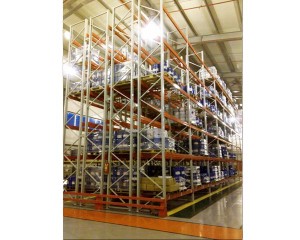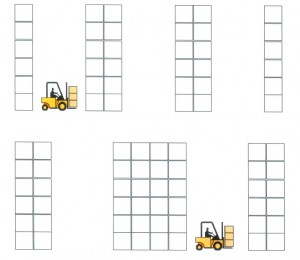Double deep racks are a version of a pallet rack that holds two rows of pallets or skids, one behind the other. When fully loaded, only the front row of pallets is accessible from the aisle in a double deep rack.
Why would anyone want to store pallets on a rack that isn’t accessible?
To save space, of course!
Double deep racks sacrifice some selectivity for more density. This means they can store more pallets, but those pallets are less accessible. Unlike a standard pallet rack where every pallet is accessible at any given time, the back row of parts in a double deep rack is only accessible when the front pallet is removed.
The best part about double deep racks is that they are simple. No fancy rollers to break down, just a low cost solution to increase density in a warehouse.
Typically, double deep racks are used when like products are to be kept in the same storage location. The row in the back containing inaccessible pallets should have the same SKU or product as the row in the front. This way the forklift driver knows that there are no mystery parts hiding behind the first row.
How does a double deep rack save space?
Double deep racks require less aisles since the pallets are stored closer together. Consider the following sketch:
The top sketch shows a standard arrangement of selective pallet racks. There are three aisles, with six racks or columns of pallets. Each pallet is easily accessed by the forklift.
The lower sketch shows the same foot print with double deep racks. Now only two aisles and four double deep racks are used to store eight columns of pallets. This scenario stores 30% more pallets than the standard selective pallet rack set up, at the cost of burying half of the pallets.
How do you access the back pallets in a double deep rack?
Even with the front pallets removed, a standard fork lift or reach truck cannot reach the back row of pallets because the load beams from the front row prevent the truck from getting close enough.
Warehouses with double deep racks use specialized fork extensions on each forklift. These longer forks can reach past the first load beams to the back row of pallets. Typically, aisles have to be wider to accommodate the wider turning radius of a forklift with extended forks.
In the sketch above, the aisles are wider by two feet, and double deep racks are still able to store more pallets than standard pallet racks. Work with the forklift manufacturer to determine the appropriate aisle with for your specific model of forklift.
If you are able to store multiple pallets of the same SKU or product, and you can live with the inconvenience of some added length to the forks on your reach truck, then double deep racks might be the solution for you.
Check out the Following Double Deep Rack Videos:
Double deep racks being loaded with a specialized forklift.
Double deep pallet rack video explanation.
Double deep rack 360 degree graphical overview.
Back to the main Warehouse Racking page.

